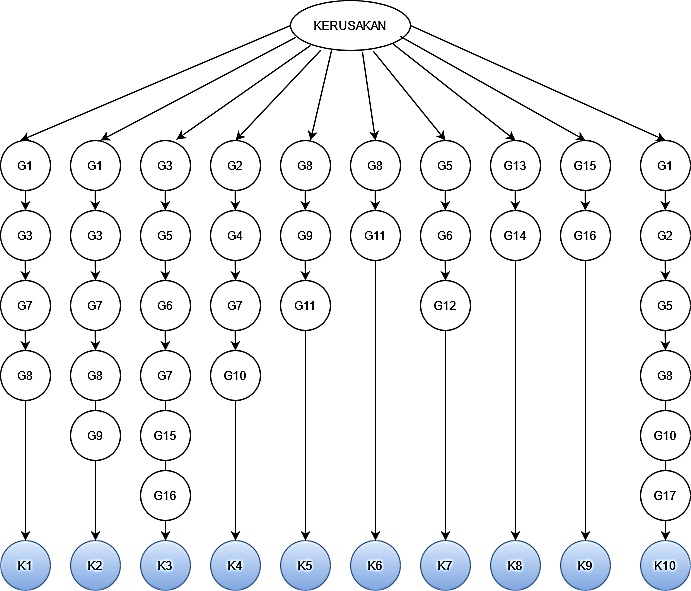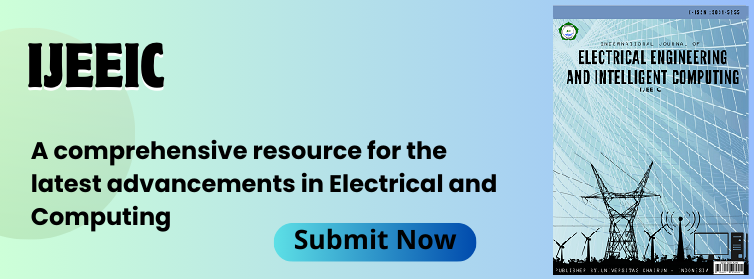
Expert System Implementation of the Certainty Factor Method for Smartphone Damage Diagnosis
Abstract
Keywords
Full Text:
PDFReferences
C. Liu, L. Zhou, W. Wang, and X. Zhao, “Concrete Surface Damage Volume Measurement Based on Three-Dimensional Reconstruction by Smartphones,†IEEE Sens. J., vol. 21, no. 10, pp. 11349–11360, 2021, doi: 10.1109/JSEN.2021.3067739.
H. Regenbrecht, A. Knott, J. Ferreira, and N. Pantidi, “To See and be Seen - Perceived Ethics and Acceptability of Pervasive Augmented Reality,†IEEE Access, vol. 12, no. March, pp. 32618–32636, 2024, doi: 10.1109/ACCESS.2024.3366228.
A. Gangwal and M. Conti, “Cryptomining Cannot Change Its Spots: Detecting Covert Cryptomining Using Magnetic Side-Channel,†IEEE Trans. Inf. Forensics Secur., vol. 15, pp. 1630–1639, 2020, doi: 10.1109/TIFS.2019.2945171.
A. Nikam, P. Ranade, and T. Goswami, “Diagnosis of Leprosy through AI-based Mobile Application,†2022 OPJU Int. Technol. Conf. Emerg. Technol. Sustain. Dev. OTCON 2022, pp. 1–6, 2023, doi: 10.1109/OTCON56053.2023.10114031.
W. Hashim, M. Alkhaled, A. Al-Naji, and I. Al-Rayahi, “A Review on Image Processing Based Neonatal Jaundice Detection Techniques,†7th Int. Conf. Contemp. Inf. Technol. Math. ICCITM 2021, pp. 213–218, 2021, doi: 10.1109/ICCITM53167.2021.9677654.
A. A. A. Hafez, “Multi-level cascaded DC/DC converters for PV applications,†Alexandria Eng. J., vol. 54, no. 4, pp. 1135–1146, 2015, doi: 10.1016/j.aej.2015.09.004.
K. Kaur, D. Bhalla, and J. Singh, “Fault Diagnosis for Oil Immersed Transformer Using Certainty Factor,†IEEE Trans. Dielectr. Electr. Insul., vol. 31, no. 1, pp. 485–494, 2024, doi: 10.1109/TDEI.2023.3307513.
B. Ando, S. Baglio, C. O. Lombardo, and V. Marletta, “A multisensor data-fusion approach for ADL and fall classification,†IEEE Trans. Instrum. Meas., vol. 65, no. 9, pp. 1960–1967, 2016, doi: 10.1109/TIM.2016.2552678.
Y. Madhwal, “Implementation of Tokenised Supply Chain Using Blockchain Technology,†Proc. - 21st IEEE Int. Symp. a World Wireless, Mob. Multimed. Networks, WoWMoM 2020, pp. 66–67, 2020, doi: 10.1109/WoWMoM49955.2020.00026.
H. Tamakawa and H. Yamamoto, “SfM/MVS-based Three-Dimensional Structural Diagnosis System for Damaged Houses,†Dig. Tech. Pap. - IEEE Int. Conf. Consum. Electron., vol. 2022-Janua, pp. 1–6, 2022, doi: 10.1109/ICCE53296.2022.9730248.
K. Abdur-rouf and K. Shaaban, “Development of prediction models of transportation noise for roundabouts and signalized intersections,†Transp. Res. Part D, vol. 103, no. June 2021, p. 103174, 2022, doi: 10.1016/j.trd.2022.103174.
D. Jeong, “Road Damage Detection Using YOLO with Smartphone Images,†Proc. - 2020 IEEE Int. Conf. Big Data, Big Data 2020, pp. 5559–5562, 2020, doi: 10.1109/BigData50022.2020.9377847.
A. Gadupudi et al., “An Adaptive Deep Learning Model for Crop Yield Prediction,†2024 2nd Int. Conf. Comput. Commun. Control, pp. 1–5, 2024, doi: 10.1109/IC457434.2024.10486733.
N. Kumar, D. Acharya, and D. Lohani, “An IoT-Based Vehicle Accident Detection and Classification System Using Sensor Fusion,†IEEE Internet Things J., vol. 8, no. 2, pp. 869–880, 2021, doi: 10.1109/JIOT.2020.3008896.
H. Shang et al., “Spatial Prediction of Landslide Susceptibility Using Logistic Regression (LR), Functional Trees (FTs), and Random Subspace Functional Trees (RSFTs) for Pengyang County, China,†Remote Sens., vol. 15, no. 20, 2023, doi: 10.3390/rs15204952.
A. N. Tusher, S. Islam, M. T. Islam, S. R. Sammy, M. S. Rahman, and M. S. Sadik, “User Perspective Bangla Sentiment Analysis for Online Gaming Addiction using Machine Learning,†6th Int. Conf. I-SMAC (IoT Soc. Mobile, Anal. Cloud), I-SMAC 2022 - Proc., pp. 538–543, 2022, doi: 10.1109/I-SMAC55078.2022.9987343.
N. Aslam et al., “Explainable Classification Model for Android Malware Analysis Using API and Permission-Based Features,†Comput. Mater. Contin., vol. 76, no. 3, pp. 3167–3188, 2023, doi: 10.32604/cmc.2023.039721.
DOI: https://doi.org/10.33387/ijeeic.v1i2.7810
Refbacks
- There are currently no refbacks.

This work is licensed under a Creative Commons Attribution-NonCommercial-ShareAlike 4.0 International License.
| Journal Policies | Submissions | People | Â Information |
International Journal Of Electrical Engineering And Intelligent Computing
Departement of Electrical Engineering, Faculty of Engineering, Universitas Khairun,
Address: Yusuf Abdulrahman No. 53 (Gambesi) Ternate City - Indonesia
Email: ijeeic.unkhair@gmail.com

International Journal of Electrical Engineering and Intelligent Computing (IJEEIC), Universitas Khairun This work is licensed under a Creative Commons Attribution-NonCommercial-ShareAlike 4.0 International License.



